30-Year Eagle Take Permit Rule: "Sustainable Take"
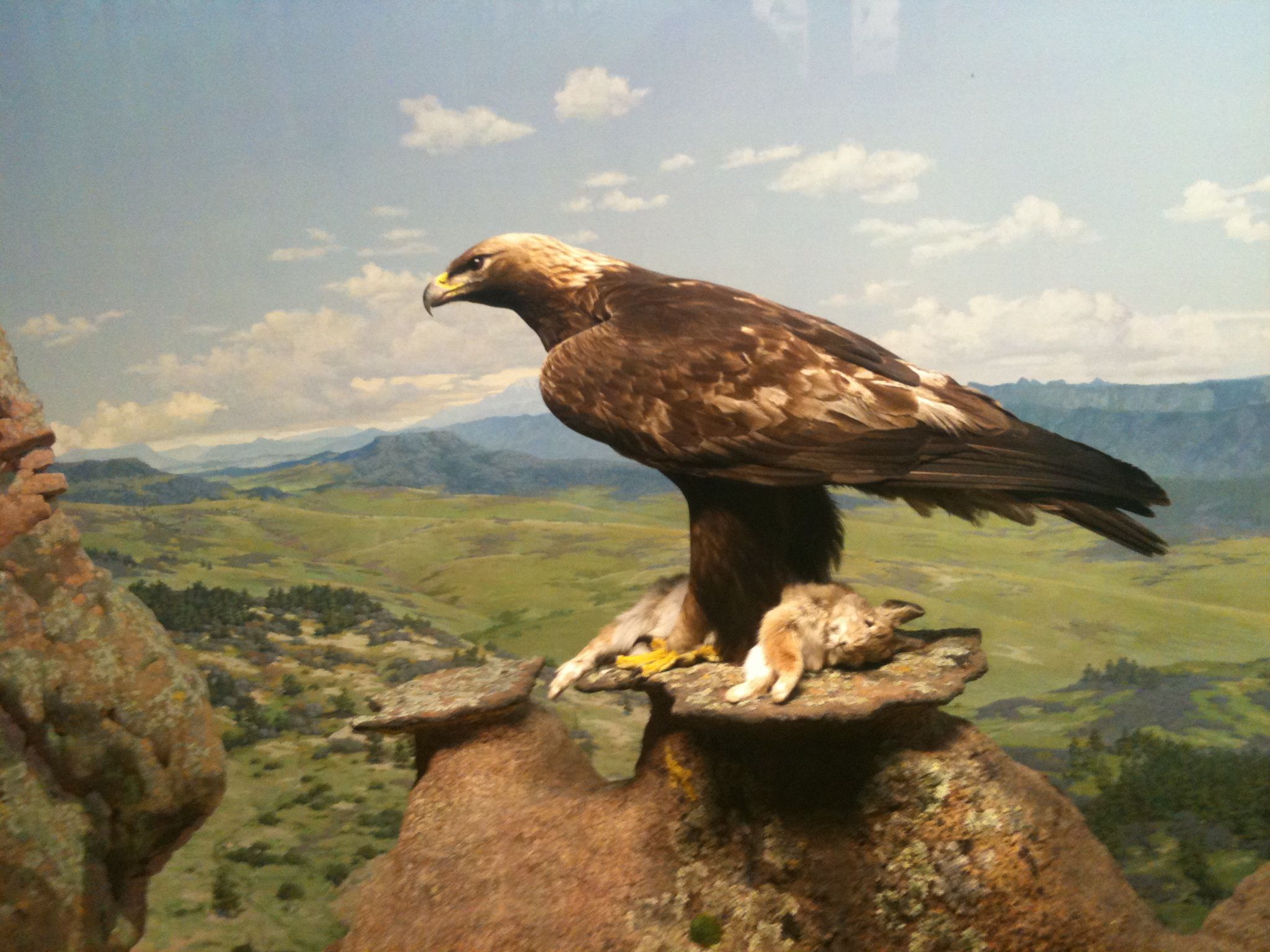
December 15, 2016 - U.S. Fish and Wildlife Service (USFWS) revised the regulations for eagle nonpurposeful take 5-year permits and eagle nest take permits on Wednesday, extending the maximum permit duration for eagle incidental take permit to 30 years.
While admitting golden eagles are declining in the western U. S., the Fish and Wildlife Service decided that such a thing as "Sustainable Take" is possible.
USFWS seems to have a twisted math version of conservation biology, where after doing a modeling study of eagle populations in the U.S. they admit that golden eagles are declining, and 56% of mortality is from human causes. But then they say in order to benefit the "regulated community" (i.e. companies), they have come up with the "Sustainable Take" concept. Which to us is an oxymoron since allowing take (killing, harming) is not recovering a declining species.
The USFWS says:
"Sustainable take (the number of eagles that can be removed from the population while still achieving a stable population compared to the 2009 baseline) of golden eagles under those conditions would be 2,000 individuals (20th quantile = 1,600). The available information suggests ongoing levels of human-caused mortality likely exceed this value, perhaps considerably. This information supports the finding from the population model that golden eagle populations may be declining to a new, lower level" (USFWS Eagle Permits revision, page 11).
How is that sustainable? They claim this will allow for more compensatory mitigation to be done, but American Bird Conservancy rightly commented that these mitigation measures are not guaranteed to work, and their success is questionable.
We can see the side of the agency in wanting to collect more data, encourage companies to apply for take permits, and try to build up a suite of mitigation measures. But the encouragement does little to ask developers to avoid dense eagle population areas.
Bald and Golden Eagle Protection Act
The Bald and Golden Eagle Protection Act (Eagle Act or BGEPA) prohibits take of bald eagles and golden eagles except pursuant to federal regulations, in order to maintain or increase eagle populations. However, the Eagle Act authorizes the Secretary of the Interior to issue regulations to permit the incidental “taking” of eagles during other legal activities, and allowing wind companies (and other deveopments such as transmission lines carrying coal-generated electrivity) a certain number of killed or injured eagles at their projects. The USFWS claims this will be consistent with keeping eagle populations stable or on the increase.
In 2012 the USFWS extended this take permit from 5 to 30 years. This was the subject of a legal challenge, and the court agreed that better environmental review had to be done. The USFWS went back and did NEPA (National Environmental Policy Act) review, took in hundreds of public comments, and made revisions to their rule.
This may encourage companies to seek take permits (which are voluntary), something that was rarely happening before these revisions. Then compensatory mitigation can be authorized--compensatory mitigation being specific conservation actions to replace or offset project-induced mortality or disturbance by reducing take elsewhere. But the fine line of protection versus mitigation may be crossed, as the service decided to allow much rarer golden eagle populations in the eastern U. S. to also be under this take permit rule, where previously they were not allowed to have take. USFWS also admits in their rule that western populations of golden eagles are declining.
But instead of halting the continued development of development projects in sensitive areas and wild lands with golden eagle populations, the service is increasing the mortality limit, partly to "benefit" the "regulated community" (ibid. page 7). Supposedly the permitted projects will then have to undertake conservation measures, but these are not guaranteed to work. The USFWS admits, "In fact, the Service’s recent analysis of causes of death of golden eagles shows that, 56 years after enactment of the Eagle Act, unpermitted human-caused mortality is still the leading cause of death of golden eagles in the United States, and risks causing population declines for this species" (ibid. page 8).
Bald eagles
The agency determined that at present population levels, a take limit of 3,742 bald eagles in the United States is sustainable by the species with mitigation.
The agency hopes that "more ongoing unpermitted take" will now be permitted. If mitigation does not work, all this does is change an uncounted mortality of eagles to an official tally of dead eagles. There is no mention of avoiding eagle mortality by not allowing energy and transmission projects to be built in the first place in areas with eagles.
Golden eagles
The Fish and Wildlife Service says: "We estimate golden eagles currently number about 40,000 individuals in the United States (including Alaska), and populations have been relatively stable around that size since the mid-1960s. We estimate the carrying capacity of golden eagles nationwide to be 73,000. We also have data indicating that population size is limited by high levels of anthropogenic mortality (i.e., populations could be larger were it not for ongoing high levels of unpermitted take), and that adding additional mortality will likely cause populations to decline to a lower level. As a consequence, there is no opportunity for authorizing additional unmitigated take of this species without changing the population objective to a level lower than the 2009 baseline. Under our proposed management framework, we would operate under the conservative assumption that there is no sustainable take, and take limits would be zero, without compensatory mitigation to offset the take" (ibid. page 16).
The Service goes on to say: "The best available information indicates that ongoing levels of human-caused mortality of golden eagles likely exceed sustainable take rates, potentially significantly. This means that the golden eagle population is likely in decline and not meeting the Service’s preservation goal of a stable or increasing breeding population" (ibid. page 40). Whether mitigation measures to offset take will help golden eagle populations stabilize is something the interested public should keep close track of.
Incidental Take Permits
Revised permits will incorporate a local area population (LAP) cumulative effects analysis into the permit issuance criteria. If take exceeds 5% of the estimated population size within the LAP area, additional take is considered inadvisable unless the permitted activity will actually result in a lowering of take levels, such as by repowering older wind projects. So the agency is saying that even at a 5% mortality, wind companies are still allowed to continue with operations, and any measures to lower take are voluntary.
To issue a take permit, a LAP cumulative effects analisys is required, and the cumulative authroized take must not exceed 5%. But the project may go above 5% if compensatory mitigation will offset mortality, or for existing projects if permit conditions would result in lowered take.
The agency estimates that a background of an average of 10% anthropogenic mortality is happening already to golden eagles, so the 5% take permit would add to this.
Nest take permits will also be issued in cases of a safety emergency, but that definition is left vague. Eggs and nestlings mayb be allowed to be removed and placed in a foster nest.
Wind Energy and Fossil Fuel Transmission
"Submission of inadequate data, or data gathered using methods the Service cannot verify to be sound, has resulted in significant extra work and time from our staff to assess wind energy project impacts," according to the Fish and Wildlife Service. They now have protocols for pre-application surveys, fatality predictions, and monitoring.
But these new revisions apply to all permitted activities where companies may need to follow Bald and Golden Eagle Protection Act guidelines, including transmission lines that may carry coal generation in the future.
See also https://abcbirds.org/article/new-eagle-management-rule-leaves-eagles-risk/
Studying Impacts to Golden Eagles From Wind and Solar
^Golden eagle.
February 26, 2014 - At the 39th Annual Desert Tortoise Council Symposium in Ontario, California, a session was held on golden eagle and other raptor research being done in the deserts of California and Nevada concerning their status, behavior, movements, and protection.
Nevada Golden Eagle Nest Surveys
Nest surveys undertaken from 2003 to 2011 by John Boone of the Great Basin Bird Observatory and Cris Tomlinson of the Nevada Division of Wildlife (NDOW) produced a density map of golden eagle nest surveys for Nevada. These were aerial (helicopter) and ground surveys in an attempt to cover the whole state and fill in gaps in knowledge of where breeding territories are, so NDOW can better manage for renewable energy impacts. What we noticed on the slide was how dense the southern tip of Clark County was -- many nests, and denser than in large areas of the state. It appeared to include the Searchlight Hills and surrounding mountains around Laughlin perhaps. This area has a proposal by Duke Energy for a large-scale wind project, which would not be compatible with such a dense concentration of eagle territories. Boone said golden eagle trends are stable to slowly declining across the western U.S. Boone estimated there could be approximately 3,000 breeding golden eagles in Nevada.
Golden Eagle Nest Surveys in California
Carl Thelander of BioResource Consultants discussed the history of egg collection in southern California, and how these records can inform the changes in knowledge of eagle nests. Egg collecting was a popular hobby in the 1800s. In 2012 the Bureau of Land Management and US Fish and Wildlife Service undertook golden eagle nest surveys in the desert, using both helicopter flights and ground surveys. 397 nests were found in the California Desert in 2012, although many nests are multiple nests in single territories. Eagles move around from nest to nest in different years, and 8-10 nest structures are in a given territory. Therefore the estimate was of 74 eagle territories. This may be a bad year, with around 100 nesting pairs more usual in a good year. 1.2 eggs were successfully fledged per nest. Some nests may be 100 years old, used over and over until they are tall stick plies. One nest was 20 feet tall on a cliff.
There has been attrition in the Mojave Desert as golden eagles are gradually wiped out by development, shooting, off-road disturbance, rock climbing, urbanization, renewable energy projects, and transmission lines.
Prairie falcons and great-horned owls also nest in desert cliffs, and even peregrine falcons -- four pairs were found nesting in the Mojave Desert during surveys, using golden eagle nests.
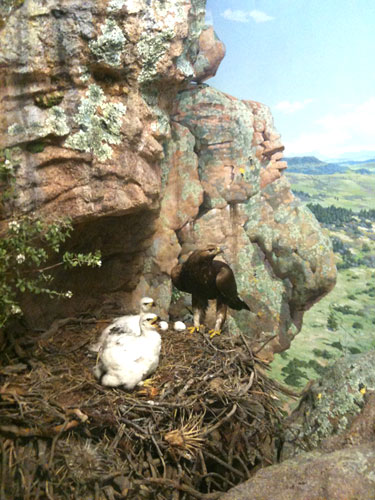
^Golden eagle nest on a cliff from a museum display.
Altamount Pass Wind Impacts
Douglas Bell of the East Bay Regional Park Department explained his research in the Altamount Pass area of the South Coast Range of California, east of the Bay Area. Mitigation there may be moving specific turbines 10 meters away from a windward slope to a leeward slope where raptors fly less based on intensive observations of raptor flight behavior. But as a complication, red-tailed hawks used slopes in a different manner than golden eagles which were more general in their foraging habitat. Detailed models are being mapped out showing where various raptor species are most likely to be flying, including slope, aspect, and elevation, with the hope of placing turbines on less used slopes.
Bell showed photos of golden eagles there that had broken wings or a wing cut off by turbine collision that then walked over the ground a mile or more, out of the wind project boundary so they were not immediately killed and found. One eagle with a broken wing walked across a grassy valley to another ridge and was found and taken to a wildlife rescue center but later died. So not all eagles are even detected when they get hit by rotors.
These are the annual mortality totals for the Altamount Wind Resource Area's 5,400 turbines (580 MW, over 427 square miles):
--Red-tailed hawk - 253 killed/year
--American kestrel - 475
--Burrowing owl - 714 (may be a high estimate)
--Golden eagle - 56-70 (good estimate); 46 were killed by blade strike, 10 were killed by other wind infrastructure.
--raptors total - 1,645 or may be up to 2,000
--birds in general - 7,643 but could be closer to 10,000.
There are 58 pairs of golden eagles locally, but 167 pairs would be needed to produce enough chicks and new adults to replace this loss at the wind projects there.
The Altamount Pass area saw the first wind development in the 1908s, small projects which incrementally added up to big projects and big problems. Dead birds were found from the beginning. Bell said the jury is still out as to whether repowering wind turbines has lessened bird kills: replacing early small wind turbine generator models with large turbines. The giant new 2.3 megawatt turbines are too new and need 2-3 years of data collection still. The 1 MW turbines have now had 3 years of study, and burrowing owl mortality has dropped some for these larger turbines, but golden eagles are still being killed at the same rate.
"Floater" eagles have the highest death rates at Altamount, those eagles wandering in and not nesting. Subadults are next, then breeders, and finally juveniles. Originally there were a few eagle nests within the Altamount Pass Wind Resource Area but those are now eliminated. Stable isotope analysis was undertaken on feathers of 50 eagle carcasses to try to determine where the eagles came from geographically. 10 to 20% of feathers were grown outside of the Altamount region. These were mostly younger birds -- second year birds, but they could have stayed in the area and undergone a complete molt so sometimes their origin is not apparent. Most telemetered eagles were 2-4-year-old birds hanging out in the Diablo Range, but it is not clear where they hatched.
Many mitigation measures were attempted at Altamount with no success, such as painting colors on the rotor blades. This did not work to deter birds from colliding. The industry does not seem to like vertical-axis wind turbine generators. Mechanical deterrents have had almost no success and may be a wasted effort. Only bats have been helped somewhat by applying cut-in speeds, slowing or stopping rotor spin at certain times, but this has apparently not helped eagles.
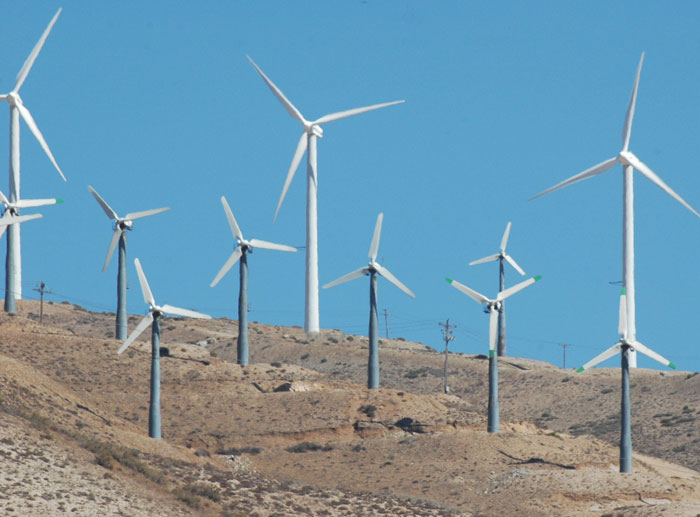
Movement of Golden Eagles in the California Desert
Todd Katzner of West Virginia University discussed his team's studies of nine telemetered eagles in 2012 and 2013. He measured their monthly home range size and terrain roughness and topography or areas used. In the desert south of Ridgecrest, California, breeding begins as early as September, October, and November. Home range sizes shrink during breeding, and expand by April and May. One male eagle that nested in the desert spent much of the summer in the Sierra Nevada mountains, raising questions of how to manage eagle territories in the Desert Renewable Energy Conservation Plan, still being written.
How Eagles Use the Aerial Environment
Adam Duerr of West Virginia University studied the flight behavior of golden eagles. Eagles use orographic lift at times, riding the winds blowing horizontally as they lift over slopes and ridges. At other times they use soaring and gliding between thermals. During windy conditions eagles might be at more risk when they use areas where wind turbines would be placed on slopes and ridges.
Red-tailed Hawk Migration
Peter Bloom of Bloom Biological Inc., shared his ongoing natal dispersal studies of red-tailed and red-shouldered hawks nesting in Orange County, California. Unlike red-tailed hawks hatching in northern California, many Orange County nesters make regular long distance movements across the Great Basin into Nevada, eastern Oregon, Idaho, and Utah, as well as into the Central Valley of California. These are summer movements, with many birds returning to their natal areas in southern California. Red-tails are dependent on ground squirrels, jackrabbits, and snakes, and may take advantage of the seasonal abundance during the warm months in the north. One red-tail banded as a nestling in Laguna Canyon traveled four times northwards to summer in Nevada and Idaho. Some hawks flew across the Mojave Desert, stopping the feed. This southern California population is the only migratory red-tailed hawk population known.
Red-shouldered hawks were found to stay within their natal territories for the most part. Some, however, traveled 400 to 800 kilometers as vagrants (a one-time unidirectional movement), and most of these did not survive long (22 months and under).
Breeding populations of Swainson's hawks in the Mojave Desert are on the brink of being lost, said Bloom. As late as 1979 they nested on Cima Dome, and the Antelope Valley in the western Mojave currently. The western Antelope Valley population is down to a dozen territories, down by two-thirds. Wind projects, drought, and changing agricultural use are mostly to blame.
Golden eagles, too are less common in the Mojave Desert than formerly. Many historically recorded eagle territories of decades ago are now unoccupied. Lead bullets, transmission electrocution, and wind projects are negative impacts.
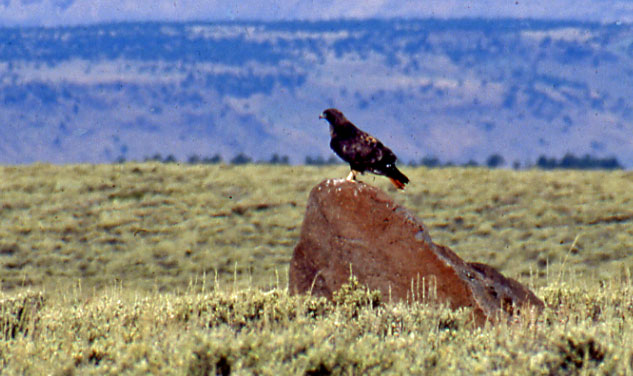
^Red-tailed hawk summering in the sagebrush habitats of eastern Oregon.
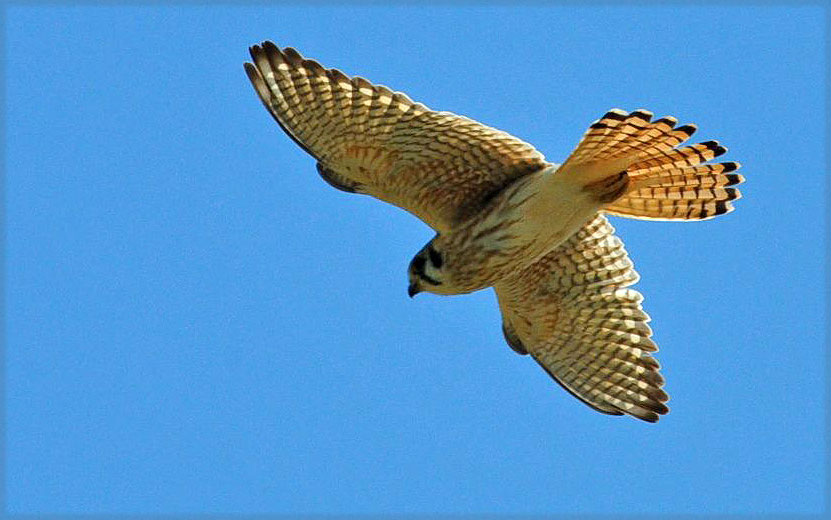
^American kestrel.
In Conclusion: No Plan
Scott Flint who is working on the Desert Renewable Energy Conservation Plan (DRECP) stated in a discussion with the eagle panel that the problem is there is no plan yet, the DRECP is not out.
We were disappointed that no discussion followed about impacts to raptors from the 500-700 foot tall solar power towers being constructed and planned for the deserts. Being much taller than wind turbines, these could impact even high-flying golden eagles using thermals to migrate or travel long distances. Solar plants might even create thermals that would attract eagles. More study is needed.
Instead of waiting for these valuable studies to inform decision-making, and allow researchers to collect much-needed data, the renewable energy push continues to locate large-scale wind and solar developments in eagle habitat and places which may be migration corridors and foraging grounds for a diversity of raptors and other birds.

^Ivanpah Solar Electric Generating System in an area where golden eagles have been seen soaring. Solar flux is a whole new threat to birds, the high temperatures can vaporize birds flying into the intense and concentrated solar energy. See the Hidden Hills solar power tower project page for more on solar flux.
